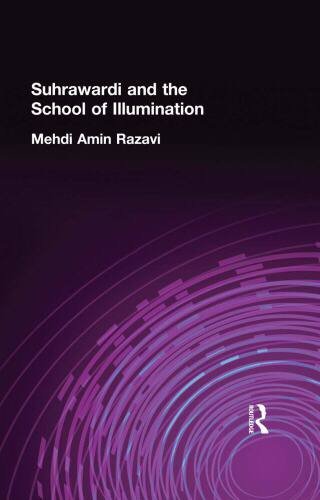

Suhrawardi and the School of Illumination by Mehdi Amin Razavi, published in 1997 by Routledge as part of the Curzon Sufi Series, is a comprehensive study of the life, works, and philosophical contributions of Shihab al-Din Yahya Suhrawardi (1154–1191 CE), the 12th-century Persian philosopher known as the \"Master of Illumination\" (Shaikh al-Ishraq). The book provides an accessible yet scholarly exploration of Suhrawardi’s Illuminationist philosophy (Hikmat al-Ishraq), which seeks to reconcile rational discourse with mystical insight, emphasizing a theory of knowledge called \"Knowledge by Presence.\" Razavi organizes the text into five key sections: The Life and Works of Suhrawardi, Central Themes, Practical Sufism, Philosophical Sufism, and The Influence of Suhrawardi on Islamic Philosophy, offering a structured analysis of his thought and legacy.
The book begins by detailing Suhrawardi’s life, a brief but prolific period marked by his training in Avicennan Peripateticism and his development of a unique philosophical system. Born in Suhraward, Persia, and executed at age 36 in Aleppo under controversial circumstances, Suhrawardi produced a significant body of work, including his magnum opus, The Philosophy of Illumination (Hikmat al-Ishraq), and several Persian treatises rich in mystical symbolism. Razavi highlights how Suhrawardi’s philosophy diverges from the Peripatetic tradition of Ibn Sina (Avicenna) by introducing a metaphysics centered on light as the fundamental constituent of reality. In this \"science of lights,\" pure, immaterial light emanates from the \"Light of Lights\" in a descending hierarchy, interacting to create a complex ontology that includes an intermediary imaginal world (alam al-mithal), akin to Platonic Forms, which governs the material realm.
Central to Suhrawardi’s thought, as Razavi explains, is the concept of \"Knowledge by Presence,\" where knowledge is gained through direct, intuitive experience rather than solely through rational or sensory means. This epistemology is articulated through a rich tapestry of myth and symbolism, blending Islamic, Zoroastrian, and Hermetic elements, particularly in his Persian mystical narratives. These narratives, which Razavi argues are integral to understanding Suhrawardi’s doctrine, serve as vehicles for conveying practical wisdom and spiritual purification, complementing his rational arguments. The book explores how Suhrawardi claimed to first discover truth through mystical insight and then sought its rational basis, bridging the gap between intellectual inquiry and inner transformation.
In the sections on Practical and Philosophical Sufism, Razavi examines Suhrawardi’s approach to spiritual practice and theoretical mysticism. Practical Sufism focuses on the spiritual path (suluk) of the seeker (salik), emphasizing asceticism and inner purification to attain divine knowledge. Philosophical Sufism delves into Suhrawardi’s metaphysical and epistemological contributions, including his critique of Avicennan concepts and his engagement with figures like Aristotle, Ibn Sina, and al-Ghazali. Razavi also addresses the debate over whether Suhrawardi was a \"Neo-Avicennian\" philosopher or a founder of a wholly original system, noting interpretations by scholars like Mehdi Ha’iri Yazdi and Hossein Ziai.
The final section traces Suhrawardi’s enduring influence on Islamic philosophy, particularly through later thinkers like Mulla Sadra, who adapted his ideas on light and existence, and the School of Isfahan. Razavi underscores the revival of interest in Suhrawardi’s work in the 20th century, largely due to Henry Corbin’s efforts to edit and study his texts. The book concludes with a bibliography and reflections on Suhrawardi’s relevance to contemporary discussions on spirituality and epistemology.
Razavi’s work is praised for its clarity, sound scholarship, and readability, making it valuable for both general readers and specialists. It positions Suhrawardi as a pivotal figure who sought to harmonize rational philosophy with mystical experience, offering insights into the nature of knowledge, reality, and spiritual growth that remain relevant today. The book is available in various formats, including paperback and eBook, and has been noted for its high ratings (5.0 out of 5 stars from five reviews on Amazon).























.jpeg)




.jpg)








.jpg)



.jpeg)

.jpeg)
.jpg)

.jpeg)










.png)






.jpeg)


.jpg)





.jpg)







.jpg)
.jpg)









.jpg)